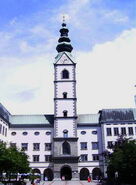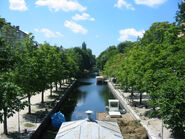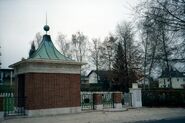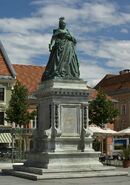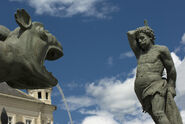| Main | Births etc |
|---|
| Klagenfurt | |||
|---|---|---|---|
| Klagenfurt | |||
|
|||
| Coordinates: Coordinates: | |||
| Country | Austria | ||
| State | Carinthia | ||
| District | Statutory city | ||
| Government | |||
| • Mayor | Christian Scheider (FPK) | ||
| Area | |||
| • Total | 120.11 km2 (46.37 sq mi) | ||
| Elevation | 446 m (1,463 ft) | ||
| Population (1 January 2014)[1] | |||
| • Total | 94,796 | ||
| • Density | 790/km2 (2,000/sq mi) | ||
| Time zone | CET (UTC+1) | ||
| • Summer (DST) | CEST (UTC+2) | ||
| Postal codes | 9020 (9010 - 9029), 9051, 9161, 9072 | ||
| Area code | 0463 | ||
| Vehicle registration | K | ||
| Website | www.klagenfurt.at | ||
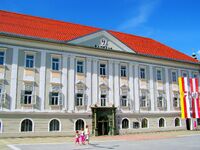
Klagenfurt City hall
Klagenfurt am Wörthersee[2] (Slovene: Celovec) is the capital of the federal state of Carinthia in Austria. With a population of over 90,000, it is the sixth-largest city in the country. The city is the bishop's seat of the Roman Catholic diocese of Gurk-Klagenfurt and home to the Alpen-Adria University.
Geography[]
Location[]
The city of Klagenfurt is located in southern Austria, midway across the nation, near the international border. It rests in the middle region, almost as far from Innsbruck, to the west, as from Vienna, to the northeast.
Klagenfurt is elevated 446 m (1,463 ft) above sea level and covers an area of 120.11 km2 (46.4 sq mi). It is on the lake Wörthersee and on the Glan River. The city is surrounded by several forest-covered hills and mountains with heights of up to 1,000 m (3,300 ft), for example, Ulrichsberg. To the south is the Karawanken mountain range, which separates Carinthia from Slovenia and Italy.
Municipal arrangement[]
Klagenfurt is divided into 16 districts:
|
|
It is further divided into 25 Katastralgemeinden. They are: Klagenfurt, Blasendorf, Ehrenthal, Goritschitzen, Großbuch, Großponfeld, Gurlitsch I, Hallegg, Hörtendorf, Kleinbuch, Lendorf, Marolla, Nagra, Neudorf, St. Martin bei Klagenfurt, St. Peter am Karlsberg, St. Peter bei Ebenthal, Sankt Peter am Bichl, St. Ruprecht bei Klagenfurt, Stein, Tentschach, Viktring, Waidmannsdorf, Waltendorf, and Welzenegg.
Climate[]
Klagenfurt has a typical Continental climate, with a fair amount of fog throughout the autumn and winter. The rather cold winters are, however, broken by occasional warmer periods due to foehn wind from the Karawanken mountains to the south. The average temperature from 1961 and 1990 is 7.1 °C, while the average temperature in 2005 was 9.3 °C.
| Climate data for Klagenfurt | |||||||||||||
|---|---|---|---|---|---|---|---|---|---|---|---|---|---|
| Month | Jan | Feb | Mar | Apr | May | Jun | Jul | Aug | Sep | Oct | Nov | Dec | Year |
| Average high °C (°F) | 0.3 (32.5) |
4.4 (39.9) |
10.3 (50.5) |
14.9 (58.8) |
20.2 (68.4) |
23.6 (74.5) |
26.5 (79.7) |
25.1 (77.2) |
20.6 (69.1) |
14.2 (57.6) |
5.8 (42.4) |
−0.8 (30.6) |
13.76 (56.76) |
| Average low °C (°F) | −7.2 (19.0) |
−5.4 (22.3) |
−1.3 (29.7) |
2.8 (37.0) |
7.8 (46.0) |
11.1 (52.0) |
12.9 (55.2) |
12.7 (54.9) |
9.0 (48.2) |
4.3 (39.7) |
−1 (30.2) |
−5.2 (22.6) |
3.4 (38.08) |
| Precipitation mm (inches) | 30.9 (1.217) |
35.2 (1.386) |
50.2 (1.976) |
64.5 (2.539) |
78.5 (3.091) |
113.5 (4.469) |
117.6 (4.63) |
98.6 (3.882) |
89.7 (3.531) |
82.9 (3.264) |
78.9 (3.106) |
48.9 (1.925) |
889.4 (35.016) |
| Avg. precipitation days | 5 | 5 | 6 | 8 | 10 | 12 | 10 | 9 | 7 | 7 | 7 | 5 | 91 |
| Source: World Meteorological Organisation (UN) [3] | |||||||||||||
Name[]
Carinthia's eminent linguists Primus Lessiak and Eberhard Kranzmayer assumed that the city's name, which literally translates as "ford of lament" or "ford of complaints", had something to do with the superstitious thought that fateful fairies or demons tend to live around treacherous waters or swamps. In Old Slovene cviljovec is a place haunted by such a wailing female ghost or cvilya.[4] Thus they assumed that Klagenfurt's name was a translation made by the German settlers of the original Slovene name of the neighbouring wetland. However, the earliest Slovene mention of Klagenfurt in the form of "v Zelouzi" ('in Celovec', the Slovene name for Klagenfurt) dating from 1615[5] is 400 years more recent and thus appears to be a translation from German. The latest interpretation, on the other hand, is that the Old Slovene cviljovec itself goes back to an Italic l'aquiliu meaning a place at or in the water, which would make the wailing-hag theory obsolete.[6]
Scholars had at various times attempted to explain the city's peculiar name: In the 14th century the abbot and historiographer John of Viktring translated Klagenfurt's name in his Liber certarum historiarum as Queremoniae Vadus, i.e. "ford of complaint", Hieronymus Megiser, Master of the university college of the Carinthian Estates in Klagenfurt and editor of the earliest printed history of the duchy in 1612, believed to have found the origin of the name in a "ford across the River Glan",[7] which, however, is impossible for linguistic reasons. The common people also sought an explanation: A baker's apprentice was accused of theft and executed, but when a few days afterwards the alleged theft turned out to be a mistake and the lad was proved to be totally innocent, the citizens' "lament (= 'Klagen') went forth and forth". This story was reported by Aeneas Silvius Piccolomini, who later became Pope Pius II.[8]
In 2007 the city changed its official name to "Klagenfurt am Wörthersee" (i.e., Klagenfurt on Lake Wörth). However, since there are no other settlements by the name of Klagenfurt anywhere, the previous shorter name remains unambiguous.
History[]
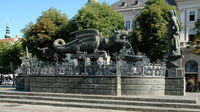
Lindwurm fountain in the city centre

Duke Bernhard of Spanheim, the founder of the City
Legend has it that Klagenfurt was founded after a couple of brave men had slain the abominable "Lindwurm", a winged dragon in the moors adjoining the lake, the staple diet of which is said to have been virgins, but which did not spurn the fat bull on a chain that the men had mounted on a strong tower. The feat is commemorated by a grandiose 9-ton Renaissance monument in the city centre.
Historically, the place was founded by the Spanheim Duke Herman as a stronghold sited across the commercial routes in the area. Its first mention dates from the late 12th century in a document in which Duke Ulric II. exempted St. Paul's Abbey from the toll charge "in foro Chlagenvurth".[9] That settlement occupied an area that was subject to frequent flooding, so in 1246 Duke Herman's son, Duke Bernhard von Spanheim moved it to a safer position and is thus considered to be the actual founder of the market place, which in 1252 received a city charter.
In the following centuries Klagenfurt suffered fires, earthquakes, invasions of locusts and attacks from Turks, and was ravaged by the Peasants' Wars. In 1514 a fire almost completely destroyed the city, and in 1518 Emperor Maximilian I, unable to rebuild it, despite the loud protests of the burgers, ceded Klagenfurt to the Estates, the nobility of the Duchy. Never before had such a thing happened. The new owners, however, brought about an economic renaissance and the political and cultural ascendancy of Klagenfurt. A canal was dug to connect the city to the lake as a supply route for timber to rebuild the city and to feed the city's new moats; the noble families had their town houses built in the duchy's new capital, the city was enlarged along a geometrical chequer-board lay-out according to the Renaissance ideas of the Italian architect Domenico dell'Allio; a new city centre square, the Neuer Platz, was constructed; and the new fortifications that took half a century to build made Klagenfurt the strongest fortress north of the Alps.
In 1809, however, the French troops under Napoleon destroyed the city walls, leaving, against a large sum collected by the citizens, only one eastern gate (which was pulled down to make way for traffic some decades later), and the small stretch in the west which is now all that is left of the once grand fortifications. In 1863 the railway connection to St. Veit an der Glan boosted the city's economy and so did the building of the Vienna-Trieste railway that brought the city an imposing central station (destroyed in World War II) and made Klagenfurt the absolute centre of the region.
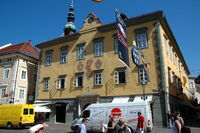
Former city hall, Alter Platz.
During the 19th century, the city developed into an important centre of Carinthian Slovene culture. Many important Slovene public figures lived, studied or worked in Klagenfurt, among them Anton Martin Slomšek, who later became the first bishop of Maribor and was beatified in 1999, the philologists Jurij Japelj and Anton Janežič, the politician Andrej Einspieler, and the activist Matija Majar. The Slovene national poet France Prešeren also spent a short part of his professional career there. On the initiative of bishop Slomšek, teacher Anton Janežič and vicar Andrej Einspieler on 27 July 1851 in Klagenfurt the Hermagoras Society publishing house was founded,[10] which in 1919 moved to Prevalje and then in 1927 to Celje, but was re-established in Klagenfurt in 1947. Several Slovene language newspapers were also published in the city, among them the Slovenski glasnik. By the late 19th century, however, the Slovene cultural and political influence in Klagenfurt had declined sharply, and by the end of World War One, the city showed an overwhelmingly Austrian German character.
Nevertheless, in 1919, the city was occupied by the Army of the Kingdom of Serbs, Croats and Slovenes and claimed for the newly-founded South-Slav kingdom. In 1920, the Yugoslav occupying forces withdrew from the town centre, but remained in its southern suburbs, such as Viktring and Ebenthal. They eventually withdrew after the Carinthian Plebiscite in October 1920, when the majority of voters in the Carinthian mixed-language Zone A decided to remain part of Austria.
In 1938 Klagenfurt's population suddenly grew by more than 50% through the incorporation of the town of St. Ruprecht and the municipalities of St. Peter, Annabichl, and St. Martin. But during WWII, the city was bombed 41 times, the bombs killing 612 people, completely destroying 443 buildings, and damaging 1,132 others. 110,000 cubic metres of rubble had to be removed before the citizens could set about rebuilding their city.
In order to avoid further destruction and a major bloodshed, on May 3, 1945 General Löhr of Army Group E (Heeresgruppe E) had agreed to declare Klagenfurt an "open city" "in case Anglo-American forces should attack the city", a declaration that was broadcast several times and two days later also published in the Kärntner Nachrichten.[11]
On 8 May 1945, 9:30 a.m., British troops of the Eighth Army under General McCreery entered Klagenfurt and were met in front of Stauderhaus by the new democratic city and state authorities. All the strategic positions and important buildings were immediately seized, and Major General Horatius Murray was taken to General Noeldechen for the official surrender of the 438th German Division. Three hours later groups of partisans arrived on a train which they had seized in the Rosental valley the day before, and Yugoslav regular forces of the IVth army moved in at the same time,[12] both claiming the city with its South Carinthian hinterland and immediately establishing a Komanda staba za Koroška, afterwards named the "Commandantura of the Carinthian Military Zone" under Major Egon Remec[13] after they had made their way through the streets jammed with tens of thousands of Volksdeutsche refugees and masses of soldiers of all the nationalities that had been fighting under German command and were now fleeing the Russians. On Neuer Platz - renamed "Adolf Hitler Platz" in 1938 - British armoured vehicles [14] are said to have faced allied Yugoslav ones in a hostile way, which would have been a curious spectacle for the liberated burghers, but this is probably one more of those modern legends.
From the beginning of 1945, when the end of the war was rather obvious, numerous talks among representatives of democratic pre-1934 organisations had taken place, which later extended to high-ranking officers of the Wehrmacht and officials of the administration. Even representatives of the partisans in the hills south of Klagenfurt were met who, in view of the strong SS-forces in Klagenfurt, agreed not to attempt to take the city by force,[15] but upheld the official declaration that Carinthia was to be a Yugoslav possession.[16]
On May 7, a committee convened in the historic Landhaus building of the Gau authorities in order to form a Provisional State government, and one of the numerous decisions taken was a proclamation to the "People of Carinthia" reporting the resignation of the Gauleiter and Reichsstatthalter Friedrich Rainer, the transfer of power to the new authorities, and an appeal to the people to decorate their homes with Austrian or Carinthian colours, which was printed in the Kärntner Zeitung of May 8. When on the following day Yugoslav military demanded of Klagenfurt's new mayor that he remove the Austrian flag from the city hall and fly the Yugoslav flag, the acting British Town Officer Cptn. Watson immediately prohibited this but also orderered that the Austrian flag be taken down.[17] Accompanied by a guerrilla carrying a machine pistol a Yugoslav emissary appeared on the same day in the Landesregierung building, demanding of the Acting State Governor Piesch repeal the order to take down the Yugoslav flag, which was ignored.
Several days passed before under British pressure with US diplomatic backing the Yugoslav troops withdrew from the city proper,[18] not before establishing a parallel Carinthian-Slovene civil administration, a Carinthian National Council presided over by Franc Petek. However, protected by British soldiers, the members of the Provisional State Government went about their responsible business devising a comprehensive concept to cover the new political, sociological and economic situation in the land, which would serve the British military authorities. Rapid financial assistance and the restitution of property to the victims of the Nazi regime was necessary. This posed a problem because one of the very first actions of the British had been to confiscate all the property of the Nazi Party, to freeze all bank accounts and to block all financial transfers. It took months before basic communication and public transport, mail service and supply were working again, to some extent at least. During the years that followed these turbulent days a major part of the British Eighth Army, which in July 1945 was re-constituted as British Troops in Austria (BTA), had their headquarters in Klagenfurt, since Carinthia together with neighbouring Styria formed the British occupation zone in liberated Austria, a state of affairs which lasted until 26 Oct. 1955.
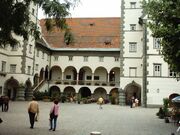
"Landhaus", the palace of the Estates, now State Assembly.
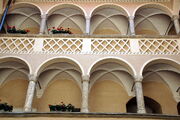
Arcaded yard in the former city hall.
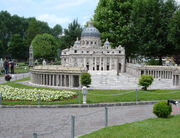
Model of St. Peter's, Rome, in Minimundus.
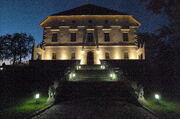
Loretto after renovation 2007.

Tentschach Castle.
In 1961, Klagenfurt became the first city in Austria to adopt a pedestrian zone. The idea of a friendly twinning of cities in other countries that had started with the very first ever city partnership - Klagenfurt and Wiesbaden, Germany, as early as 1930 - was followed up by numerous city partnerships with the result that in 1968 Klagenfurt was honoured with the title of a "European City of the Year". Three times, a European record, Klagenfurt was also awarded the prestigious Europa Nostra Diploma of Merit for the exemplary restoration and redevelopment of its ancient centre.
In 1973 Klagenfurt absorbed four more adjacent municipalities - Viktring with its grand Cistercian monastery, Wölfnitz, Hörtendorf, and St. Peter am Bichl, increasing the population of Klagenfurt to about 90,000.
Sights[]
The Old City with its central Alter Platz (Old Square) and the Renaissance buildings with their charming arcaded courtyards is a major attraction. Notable landmarks also include:
- Lindworm fountain of 1593, with a Hercules added in 1633
- Landhaus - Palace of the Estates, now the seat of the State Assembly.
- the Baroque cathedral, built by the then Protestant Estates of Carinthia
- Viktring Abbey
- Hypo-Arena Football stadium
- Minimundus, the "small world on lake Wörthersee"
- the Kreuzbergl nature park with a viewing tower and observatory
- the small but attractive botanical garden at the foot of Kreuzbergl, with a mining museum attached
- Wörthersee, the warmest of the large Alpine lakes, with Europe's largest non-sea beach and lido taking 12,000 bathers on a nice summer day.
- Maria Loretto peninsula with its newly renovated stately home, until recently in the possession of one of Carinthia's noble families, the Rosenbergs, but acquired lately by the city.
- Tentschach and Hallegg castles.
Economy[]
Klagenfurt is the economic centre of Carinthia, with 20 % of the industrial companies. In May 2001 there were 63,618 employees in 6,184 companies here. 33 of these companies counted more than 200 employees. The prevalent economical sectors are light industry, electronics, and tourism. There are also several printing offices.
Transport[]
Klagenfurt Airport is a small international airport connecting to some major cities in Europe and holiday resorts abroad.
There is also a Klagenfurt Hauptbahnhof (German: central station) located south of the city centre.
The city is situated at the intersection of the A2 and S37 motorways. The A2 autobahn runs from Vienna via Graz and Klagenfurt to Villach and further to the state border of Italy. The S37 freeway runs from Vienna via Bruck an der Mur and Sankt Veit an der Glan to Klagenfurt. The Loibl Pass highway B91 goes to Ljubljana, the capital of Slovenia, which is only 88 km (55 mi) from Klagenfurt.
The volume of traffic in Klagenfurt is high (motorisation level: 572 cars/1000 inhabitants in 2007).[19] In the 1960s, with the last streetcar (tram) line demolished, Klagenfurt was meant to become a car-friendly city, with lots of wide roads. A motorway was even planned which was to cross the city partly underground, but which now by-passes the city to the north. The problem of four railway lines from north, west, south and east meeting at the central station south of the city centre and strangulating city traffic has been eased by a considerable number of underpasses on the main arteries. Nevertheless, despite 28 bus lines, traffic jams are frequent nowadays as in most cities of similar size. Ideas of a rapid transport system using the existing railway rails, of an elevated cable railway to the football stadium, or of a regular motorboat service on the Lend Canal from the city centre to the lake have not materialized. But for those who fancy leisurely travel there is a regular motorboat and steamer service on the lake connecting the resorts on Wörthersee. During severe winters, which no longer occur regularly, you might of course be faster crossing the frozen lake on your skates.
Culture[]
There is a civic theatre-cum-opera house with professional companies, a professional symphony orchestra, a state conservatory and concert hall; there are musical societies such as Musikverein (founded in 1826) or Mozartgemeinde, a private experimental theatre company, the State Museum, a modern art museum and the Diocesan museum of religious art; the Artists' House, two municipal and several private galleries, a planetarium in Europa Park, literary institutions such as the Robert Musil House, and a reputable German-literature competition awarding the prestigious Ingeborg Bachmann Prize.

The Artists' House, 1913/14, Architect: Franz Baumgartner
Klagenfurt is the home of a number of small but fine publishing houses, and several papers or regional editions are also published here including dailies such as "Kärntner Krone", "Kärntner Tageszeitung", "Kleine Zeitung".
Klagenfurt is a popular vacation spot with mountains both to the south and north, numerous parks and a series of 23 stately homes and castles on its outskirts. In summer the city is home to the Altstadtzauber (The Magic of the Old City) festival.
Also located here are the University of Klagenfurt, a campus of the Fachhochschule Kärnten, Carinthia University of Applied Sciences, a college of education for primary and secondary teacher training and further education of teachers as well as a college of general further education (VHS) and two institutions of further professional and vocational education (WIFI and BFI). Among other Austrian educational institutions, there is a Slovene language Gymnasium (established in 1957) and a Slovene language commercial high school. Several Carinthian Slovene cultural and political associations are also based in the city, including the Hermagoras Society, the oldest Slovene publishing house founded in Klagenfurt in 1851.[20]
In addition to cultural attractions and activities available in and around Klagenfurt, this city has one more important attribute that must be mentioned. Klagenfurt is in a central location for many other great European destinations. Klagenfurt is less than an hour's drive from Italy and Slovenia, and only a few hours from Vienna, Salzburg, Budapest, Bratislava, and Zagreb.
Education[]
Tertiary[]
- University of Klagenfurt
- Klagenfurt Campus of FH Kärnten, Carinthia University of Applied Sciences CUAS
- Pädagogische Hochschule Viktor Frankl, a college of education
- Health Science Centre with Academy for Midwifery and hospital-based Nursing School at the Klagenfurt State Hospital
Secondary[]
A number of general high schools such as
- Europa-Gymnasium, Austria's oldest
- BG/BRG Mössingerstraße
- BRG Klagenfurt-Viktring with emphasis on arts (music and drawing)
- ORG St. Ursula, a private Catholic institution
- a Slovene-language Gymnasium
and senior high schools offering general-cum-professional education:
- 2 Schools of Engineering HTL Lastenstrasse and HTL Mössingerstraße
- 2 commercial high schools: Handelsakademie #1 and #2
- a Slovene-language Commercial High School ("Handelsakademie")
- a High School of Catering, Fashion and Design
- a School of Pre-School Education
- a School of Alpine Agriculture and Nutrition Science
- a School of Social Management of the Caritas Charity
Further education[]
- College of Further Education Volkshochschule
- Technical Training Institute of the Trade Unions - Berufsförderungsinstitut (BFI)
- Technical Training Institute of the Chamber of Commerce - Wirtschaftsförderungsinstitut (WIFI)
- evening schools (Gymnasium and Schools of Mechanical and Electrical Engineering)
Others[]
- Landeskonservatorium, a state music conservatory
- a Waldorf School
- a School for Social Workers operated by the Austrian Caritas Charity
- the Carinthian State School of Fire Control
Sports[]
The Austrian ice-hockey record-champion EC KAC is one of the best known sports clubs in Austria. The "Eishockey Club Klagenfurter Athletiksport Club" has won the Austrian Championship 29 times and its fans come from all over Carinthia. The Premier League Football club SK Austria Kärnten is based in Klagenfurt. Klagenfurt hosts the Start/Finish of the Austrian Ironman Contest, 3.8 km swim 180 km bike 42 km run, part of the WTC Ironman series, which culminates in the Hawaii World Championships.
The World (European) Rowing Championships were held on the Wörthersee in 1969.
One of the FIVB's Beach Volleyball Grand Slams takes place in Klagenfurt every July and is almost always one of Austria's biggest celebrations during the year. Beach volleyball is popular in Austria even though the country is landlocked. Austrian players Clemens Doppler, Florian Gosch and Alexander Horst, who are perennial European powerhouses take part every year. The 2009 champions of this tournament were the 2008 Beijing gold medal team from the USA, Phil Dalhausser and Todd Rogers.[21]
Klagenfurt also hosted three games during the UEFA Euro 2008 Championships in the recently built Hypo-Arena. Klagenfurt was also a contender for the 2006 Winter Olympics and is home to an American Football team, the Carinthian Black Lions, competing in the First League of the Austrian Football League. The Black Lions[22] attract fans from all over Carinthia, playing home games in both Klagenfurt and Villach.
Notable natives and residents[]
- Milivoj Ašner, former Croatian Chief of Police
- Ingeborg Bachmann, poetess
- Cesar Baena, cross country skier
- [de Alfred von Buttlar-Moscon]
- Günther Domenig, architect
- Anton Pein, professional darts player
- James Aubrey (James Aubrey Tregidgo) famous British actor
- Andrej Einspieler, politician and journalist
- Felix Ermacora, human rights expert
- Heinz Goll (1934–1999), sculptor and painter
- Stephanie Graf, athlete
- Karl-Heinz Grasser, former federal minister of finance
- Emanuel Herrmann (1839–1902), national economist; one of several inventors of the postcard
- Sissy Höfferer, actress
- Anton Janežič, philologian
- Jurij Japelj, Slovene philologist and translator
- Gert Jonke, writer
- Udo Jürgens, singer/composer
- Dieter Kalt, ice hockey player
- Dagmar Koller, actress
- Stefan Koubek, tennis player
- Ernst Lerch, war criminal suspect
- Stefan Lexa, Footballer
- Matija Majar, political activist, author and ethnologist
- Penny McLean, singer
- Manfred Mocher, former keeper for the Austrian national football team
- Robert Musil, writer
- Heinz Nittel, politician in Vienna's city administration
- Danny Nucci, actor
- Vinko Ošlak, essayist
- Antonia Rados, television journalist
- Wolfgang Petritsch, diplomat,former UN High Representative in Bosnia
- Ursula Plassnik, former federal minister of foreign affairs
- Thomas Pöck, ice hockey player
- Roland Rainer, architect
- Hanns Albin Rauter, SS-general in Nazi-occupied Netherlands, executed war criminal
- Bernhard von Spanheim, Duke of Carinthia
- Josef Stefan, mathematician and physicist
- Maximilian Daublebsky von Sterneck, admiral
- Johann von Viktring, historiographer
Gallery[]
International relations[]
Twin towns — Sister cities[]
Klagenfurt is twinned with:
|
|
References[]
Bibliography[]
- Dieter Jandl, A brief history of Klagenfurt, revised edition, Klagenfurt: Heyn 2007, ISBN 978-3-7084-0222-2
- Uwe Johnson, A trip to Klagenfurt. In the footsteps of Ingeborg Bachmann, transl. by Damion Searl, Evanston, Ill. : Northwestern University Press, 2004 ISBN 978-0-8101-1796-9
- Richard Rainier Randall, The Political Geography of the Klagenfurt Plebiscite Area, PhD thesis, Clark University, Worcester, Mass. 1955
- Karl R.Stadler, Austria, London: Benn 1971 ISBN. 0-510-39311-8
- Nikolai Tolstoy, The Klagenfurt Conspiracy . War crimes & diplomatic secrets, in: Encounter vol. 60 (1983) no. 5
- Anthony Cowgill, Christopher Booker et al., Interim Report on an Enquiry Into the Repatriation of Surrendered Enemy Personnel to The Soviet Union and Yugoslavia from Austria in May 1945 and The Alleged 'Klagenfurt Conspiracy', Stroud, Gloucestershire, Royal United Service Institute for Defence Studies, 1988 ISBN 0-9514029-0-0
Notes[]
- ^ Statistik Austria - Bevölkerung zu Jahres- und Quartalsanfang, 2014-01-01.
- ^ Landesgesetzblatt 2008 vom 16. Jänner 2008, Stück 1, Nr. 1: Gesetz vom 25. Oktober 2007, mit dem die Kärntner Landesverfassung und das Klagenfurter Stadtrecht 1998 geändert werden. (link)
- ^ "World Weather Information Service – Klagenfurt". United Nations. http://www.worldweather.org/006/c00904.htm. Retrieved 19 January 2011.
- ^ Eberhard Kranzmayer, Ortsnamenbuch von Kärnten. Part II, Klagenfurt 1958, p. 119.
- ^ Dieter Jandl, A Brief History of Klagenfurt, revised edition, Klagenfurt 2007, p.8
- ^ Heinz Dieter Pohl, Kärnten. Deutsche und slowenische Namen/Koroška. Slovenska in nemška imena. In: Österreichische Namenforschung28 (2000), vols. 2–3, Klagenfurt 2000, p. 83; and also:
Paul Gleirscher, Wie Aquiliu zu Klagenfurt wurde. In: Paul Gleirscher, Mystisches Kärnten. Sagenhaftes, Verborgenes, Ergrabenes, Klagenfurt 2007, pp. 59-65. - ^ Pohl, p. 83
- ^ Jandl, p. 14
- ^ Jandl, p. 7
- ^ Janez Jeromen: 150th Anniversary of "Mohorjeva družba" Publishing House. Pošta Slovenije, Ljubljana 2001
- ^ August Walzl, Kärnten 1946. Vom NS-Regime zur Besatzungsherrschaft im Alpen-Adria-Raum. Klagenfurt: Universitätsverlag Carinthia 1985, ISBN 3-85378-235-3, p. 117
- ^ August Walzl, Kärnten 1946, p. 176f, p. 194.
All the Western sources agree on that date, contrary to Yugoslav or Slovene sources.
Karel Pušnik-Gašper and others, Gemsen auf der Lawine. Der Partisanenkampf in Kärnten, Klagenfurt: Drava 1980, pp.305 ff., still claims that Yugoslav partisan forces liberated Klagenfurt on May 7, disarming the last Hitler units.
Similarly, the Bulgarian publication Otecestvenata vojna na Bulgarija 1944-1945, Sofia 1965, vol. 3, p. 258 writes of the plans for an advance as far as Klagenfurt and Villach. This advance, however, came to a halt at Lavamünd, cf. Walzl, Kärnten 1945, pp. 178 f., 225 f., 241. - ^ Zbornik dokumentov in podatkov v narodno osvobodilni vojni jugoslovanskih narodov. Part 6, vol. 12, Ljubljana 1953-1965, pp. 493 ff.
- ^ Photos in August Walzl, Kärnten 1945, pp. 326, 327
- ^ August Walzl, Kärnten 1945, p. 127 f.
- ^ Josef Rausch, Der Partisanenkampf in Kärnten im Zweiten Weltkrieg (= Militärhistorische Schriftenreihe 39/40), Vienna 1979; August Walzl, Kärnten 1945, p. 127, 156
- ^ August Walzl, Kärnten 1945, p. 197
- ^ Report of Field Marshal Alexander to the Combined Chief of Staffs of May 15, 1945 WO 202/319/040927 (Public Record Office London: War Office, unpublished), in: Walzl, Kärnten 1945, p. 224
- ^ Statistik Austria
- ^ 150TH ANNIVERSARY OF THE ST HERMAGORAS SOCIETY. Speech of Slovene President Milan Kucan in the Palace of St Hermagoras Society: Meeting the press. Klagenfurt (Austria), 28 September 2001
- ^ ":: A1 Beach Volleyball Grand Slam Klagenfurt presented by Volksbank ::". Beachvolleyball.at. http://www.beachvolleyball.at/index.php?page=ranking&sub=matches06&saison=&sex=m. Retrieved 2011-09-15.
- ^ "Black Lions", webpage: CBLions.
- ^ "Serwis informacyjny UM Rzeszów - Informacja o współpracy Rzeszowa z miastami partnerskimi". www.rzeszow.pl. http://www.rzeszow.pl/wspolpraca-miedzynarodowa/informacja-o-wspolpracy-rzeszowa-z-miastami-partnerskimi/668,informacja-o-wsp-lpracy-rzeszowa-z-miastami-partnerskimi.html. Retrieved 2010-02-02.
External links[]
- Klagenfurt info
- Statistisches Jahrbuch der Landeshauptstadt Klagenfurt 2007, S. XXIX. Statistical Yearbook 2007 of the Capital City of Klagenfurt (PDFin German)
- Slovene postage stamp 150th anniversary of Hermagoras
- Speech of the President of Slovenia in Klagenfurt on the 150th anniversary of Hermagoras
Template:Principal cities of Austria
| ||||||||||
| |||||||||
| This page uses content from the English language Wikipedia. The original content was at Klagenfurt. The list of authors can be seen in the page history. As with this Familypedia wiki, the content of Wikipedia is available under the Creative Commons License. |






